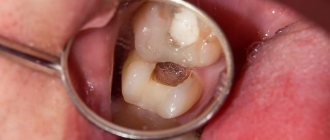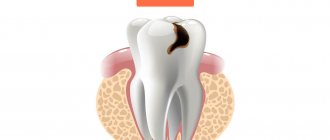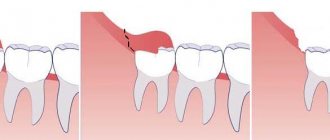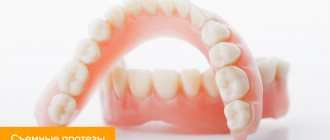Problem: a woman came to the Family Dentistry for dental prosthetics. In addition to the main reason for the visit, the patient complained of pain in the lower jaw on the left, but could not indicate the exact location. Diagnostics showed that the wisdom tooth was destroyed by caries, and there was inflammation inside the tooth - pulpitis. The woman did not want to have the tooth removed.
Solution: pulpitis of the wisdom tooth (eighth tooth) was treated with a microscope, the tooth was restored with a composite.
What is special about wisdom teeth?
The maximum set of molars for an adult is 32. In this case, it is considered normal to have 28 teeth, since four teeth are the so-called eighth molars or wisdom teeth. For some, they do not erupt at all, for others, when “eights” appear, complications and pathologies arise, but in other cases, wisdom teeth occupy the correct position in the dentition and do not bother their owner. “Eights” usually appear between the ages of 17 and 27, that is, during the period when a person has already formed an attitude towards hygiene and his own dental health. Why is it important? Due to the remote position of wisdom teeth, it is quite difficult to carry out high-quality cleaning, so only very good hygiene can reduce the risk of dental damage. In reality, it is the third molars that are in the top in terms of the number of cases of caries and its common complication - pulpitis.
Complications of pulpitis
Untimely treatment of acute pulpitis leads to a chronic process. A hidden infectious focus is formed in the body, which can provoke the appearance of both new dental diseases and general ailments, such as:
- flux - periostitis, purulent inflammation of the periosteum,
- osteomyelitis - inflammation of the bone tissue of the jaw,
- purulent inflammatory processes of intraoral tissues and soft tissues of the face,
- dental cyst - a benign neoplasm near the tips of the roots,
- sepsis - blood poisoning,
- The infection spreads to other organs through the bloodstream, with the heart and kidneys most often affected.
These diseases will require surgical or general systemic treatment - in no case should they be allowed to appear.
Pulpitis of the wisdom tooth: symptoms and treatment
Pulpitis affects the connective tissue of the tooth - the pulp. It has a crown and a root part: depending on the shape and degree of the disease, one or both parts may be affected. The symptoms of wisdom tooth pulpitis are exactly the same as in the case of other teeth.
- Painful sensations.
In acute pulpitis, the pain is acute and paroxysmal, and can be felt in the temples, ears and other parts of the jaw. The pain intensifies at night and when exposed to irritants (temperature, chemical or mechanical). With chronic pulpitis, the pain is dull and less pronounced, which makes it difficult to diagnose the disease, given the location of the wisdom tooth;
- Bleeding.
It appears only in chronic hypertrophic pulpitis, when granulation tissue grows;
- Change in tooth color.
Observed in the case of tissue necrosis with gangrenous pulpitis.
When a wisdom tooth hurts, pulpitis is just one of the options that could be the cause. To diagnose pulpitis, a visual examination, x-ray or EDI (electrodynamic diagnostics) is required. Of course, such procedures are carried out only by professionals, so if you suspect pulpitis, you should immediately make an appointment with a doctor. Most patients who face a similar problem have two questions: is wisdom tooth pulpitis treated and is it worth treating wisdom tooth pulpitis. The answer to the first question is yes, but to answer the second, you need to consider each clinical case separately.
Pulpitis
4499 19 October
IMPORTANT!
The information in this section cannot be used for self-diagnosis and self-treatment.
In case of pain or other exacerbation of the disease, diagnostic tests should be prescribed only by the attending physician. To make a diagnosis and properly prescribe treatment, you should contact your doctor. Pulpitis: causes, symptoms, diagnosis and treatment methods.
Definition _
The term “pulpitis” refers to the inflammatory process in the pulp of the tooth. The pulp is a complex connective tissue structure rich in nerve fibers and blood vessels. According to statistics, among dental diseases, pulpitis ranks second after caries, of which it is a complication.
Causes of pulpitis
The most common reason for the formation of pulpitis is advanced caries. As dentin is destroyed, the carious cavity increases; the pathogenic microorganisms present in it (streptococci, staphylococci, diplococci, enterococci, gram-positive rods, etc.) penetrate through the dentinal tubules into the pulp chamber and trigger the pathological process.
Another cause of pulpitis is sinusitis, periodontal disease, periodontitis of the nearest tooth, osteomyelitis, sepsis, when the infection enters the pulp in a retrograde manner with blood and lymph flow through the apical opening of the root.
It is impossible not to mention such a reason as a medical error - we are talking about an insufficiently carefully sealed tooth canal during the treatment of deep caries, as a result of which an infectious process begins to develop under the filling.
In rare cases, the inflammatory process in the pulp becomes a consequence of tooth trauma, deep cracks and chips of the enamel.
Classification of the disease
There are several classifications of pulpitis. In Russia, the classification proposed by the Moscow Medical Dental Institute (1989) is more often used.
Acute pulpitis:
- focal,
- diffuse.
Chronic pulpitis:
- fibrous,
- hypertrophic,
- gangrenous.
Exacerbation of chronic pulpitis:
- fibrous pulpitis,
- gangrenous pulpitis.
In addition, pulpitis is distinguished by the condition of the pulp:
- intact non-inflamed pulp,
- atrophic pulp,
- reversible pulpitis,
- irreversible pulpitis,
- pulp necrosis.
Symptoms of pulpitis
Acute focal pulpitis is manifested by sharp paroxysmal pain: at first it is insignificant, but as the inflammatory process progresses it becomes unbearable.
Often the pain is especially bothersome at night.
In advanced cases (with diffuse pulpitis), the pain radiates to neighboring teeth, and sometimes the patient cannot even determine exactly where it hurts. In the case of focal pulpitis, the affected tooth may react to cold and hot food, and the pain subsides for quite a long time. With diffuse pulpitis, hot food increases the pain, and cold food brings relief for a while.
Chronic fibrous pulpitis reminds itself of itself with aching pain, and there is a reaction to hot and solid foods. Upon examination, the enamel of a diseased tooth may be darker and dull compared to others.
Hypertrophic pulpitis is characterized by the presence of pain, as well as bleeding of the gums when eating solid foods. Patients complain of bad breath (halitosis), which occurs as a result of poor oral hygiene due to bleeding gums.
Gangrenous pulpitis is characterized by a change in the color of the affected tooth to gray, the presence of a putrid odor from the mouth, a reaction to hot and cold food, and aching pain. The gums near the tooth may be swollen and hyperemic, and the regional lymph nodes are enlarged.
Chronic pulpitis in the acute stage is diagnosed in cases where exacerbations take a severe form: the patient experiences very severe pain after a long period of “calm”. Thus, this form of the disease often combines the symptoms of acute and chronic pulpitis.
Diagnosis of pulpitis
Diagnostic measures begin with collecting an anamnesis, during which the doctor determines the presence or absence of complaints of unmotivated pain, pain from exposure to various irritants.
In the absence of obvious pain, it is clarified whether the patient experiences discomfort in the area of the affected tooth (tingling, feeling of heaviness, fullness).
During a visual examination, the doctor performs palpation, percussion, determines tooth mobility, examines periodontal tissue, pays attention to swelling and hyperemia of the gums, and palpates regional lymph nodes.
For accurate diagnosis, the following studies are used:
- radiography - to assess the degree of destruction of tooth tissue and the size of the carious cavity;
- thermal test - to determine the reaction of a diseased tooth to thermal stimuli;
- electroodontodiagnostics - to determine the sensitivity of the nerve when an electric current is passed through it.
Which doctors should I contact
? Dental diseases are treated by dental therapists.
Treatment of pulpitis
There are two ways to treat pulpitis: conservative and surgical.
Conservative treatment is indicated in the early stages of acute pulpitis. The doctor completely cleans out the carious cavity, puts an antibiotic in it and closes it with a temporary filling. After a few days, when the medicine takes effect and the infectious process is stopped, the temporary filling is replaced with a permanent one. Conservative treatment allows you to keep the tooth alive (do not remove the nerve).
Surgical treatment (depulpation of tooth canals) is carried out in 85% of cases. The doctor cleans out the carious cavity, removes the dental nerve, fills the root canals with filling material and restores the tooth crown.
If the tooth cannot be restored, it is removed.
In case of pulpitis, all manipulations with the affected tooth are carried out under anesthesia.
Complications
In the absence of timely treatment, pulp inflammation and tooth destruction progress, as a result, surrounding tissues are involved in the process, and complications such as periodontitis, gumboil, osteomyelitis, phlegmon, abscess, and cysts develop.
In rare cases, complications can be systemic in nature - sepsis, myocarditis, brain abscess.
Prevention of pulpitis
The most reliable prevention of pulpitis is oral hygiene and timely treatment of caries.
Sources:
- Clinical recommendations (treatment protocols) for the diagnosis of “dental pulp disease”. Dental Association of Russia. – 2018.
- .
- Khafizov R.G., Khafizova F.A., Azizova D.A., Shaikhutdinova D.I. Modern etiological, diagnostic and therapeutic aspects of pulpitis // Uch.-method. allowance. KFU Institute of Fundamental Medicine and Biology. - Kazan. – 2015. – 74 p.
IMPORTANT!
The information in this section cannot be used for self-diagnosis and self-treatment. In case of pain or other exacerbation of the disease, diagnostic tests should be prescribed only by the attending physician. To make a diagnosis and properly prescribe treatment, you should contact your doctor.
Pulpitis of the wisdom tooth: treat or remove?
In most cases, a wisdom tooth with pulpitis is removed. The main indications for removing a diseased “eight” are developmental pathologies, as well as being outside the bite (in this case, the tooth has no function). We are talking, first of all, about retention and dystopia. An impacted wisdom tooth is completely or partially hidden in the jaw, and a dystopic wisdom tooth has an incorrect position relative to the rest of the dentition. These pathologies in themselves are a good reason for removing the “eight”, however, if pulpitis occurs due to the impossibility of full treatment, such teeth are definitely removed.
Recommendations after manipulation of wisdom teeth
Treatment of wisdom teeth is the most unpredictable process in dentistry. The risk of developing secondary caries is one of the highest among other types of diseases. Even if nothing bothers you after dental procedures on your wisdom teeth, a preventive visit to the dentist is recommended after 6 months.
After tooth extraction or periocoronitis excision, it is recommended to strictly follow the doctor’s instructions, as they are aimed at speedy healing. If pain persists for more than 5-7 days, contact the clinic for examination.
Treatment of wisdom tooth pulpitis
Treatment of wisdom tooth pulpitis is carried out in the same way as on other teeth. In 90% of cases, the doctor performs complete removal of the pulp: only in the initial stages of chronic fibrous pulpitis is it possible to save part of the pulp. However, even if the wisdom tooth is positioned correctly and has completely erupted, very often the doctor suggests extraction rather than treatment. This is due to some features of wisdom teeth that reduce the likelihood of a successful treatment outcome.
- Location of position. Wisdom teeth are difficult to reach, and treatment of pulpitis requires almost pinpoint precision.
- Wisdom teeth have curved roots, which sometimes makes the depulpation procedure extremely difficult.
Despite the difficulty of treatment, sometimes preserving wisdom teeth is advisable. First of all, this applies to situations where, of all the molars, only “eights” remain (in the future, a prosthesis can be attached to them), as well as in the initial stages of the disease, when the chances of a successful and predictable result are higher.
Prevention of pulpitis
The following rules will help to significantly reduce the risk of pulpitis, but they must be followed carefully:
- Treat all oral diseases in a timely manner, especially caries and gum disease.
- Pay close attention to your overall health and treat any infections as soon as they are identified.
- Brush your teeth well every day, and have your teeth professionally scaled by your dentist as needed.
- Attend routine preventive examinations at the dentist every six months. By the way, such examinations once every 6 months are free of charge.
- Treat your teeth in a reliable, trusted place to minimize medical errors and complications after treatment.
Pulpitis in children
Unlike adults, children's dental pulpitis develops not due to improper oral care or caries, but due to the characteristics of milk teeth: the enamel of children's teeth is thin and poorly protected, the hard tissue of the tooth is poorly mineralized. Because of this, pulpitis occurs quite often in children.
The symptoms of childhood pulpitis do not differ from those of adults, but there are some nuances in the course of this disease: in children it is less painful; in the acute stage, there may be an increase in temperature and inflammation of the lymph nodes, the appearance of flux, and swelling of the soft tissues. Children's pulpitis is treated in the same way as adults: after examination and analysis of the clinical picture, the dentist decides how the treatment will proceed - with preservation of the pulp and nerve or not.
View clinical cases Before and After, make an appointment,
You can visit the VID clinic Instagram @denta_vid_rostov_ Also, registration is available by phone
8(863)2098902.
Depulpation: one of the main methods of treating pulpitis
To treat pulpitis, different methods are used, but most often tooth depulpation is performed. This procedure involves opening the tooth, removing the nerve bundle, and treating the canals. The canal cavities are not only thoroughly and efficiently washed with an antiseptic solution, but also filled with filling material. Popularly, this procedure is called a simple phrase - removal of the dental nerve. Pulp removal is a procedure that doctors try to resort to when it is not possible to carry out conservative treatment of pulpitis. Removing a bundle of vessels and capillaries makes the tooth fragile and vulnerable to external factors, and can cause a change in the shade of the enamel coating. But in order to be able to carry out conservative treatment of pulpitis, you need to contact a doctor as early as possible, and not wait until incessant pain appears.
Causes of pulpitis
A carious lesion of great depth is formed if caries remains untreated for a long time. From this focus, infection penetrates into the pulp, which provokes inflammation. This is not the only possible reason:
- as a result of careless actions of the dentist, a fracture or bruise, the dental crown is damaged;
- retrograde infection (infection occurs as a result of exacerbation of chronic diseases - osteitis, periodontitis, etc.);
- the effect of medications: antiseptics for treating teeth in too high concentrations, toxic filling agents;
- overheating of the pulp during enamel bleaching and other procedures.
The inflammatory process can begin as a result of mechanical, temperature, chemical effects, or when an infection occurs.
Pulpitis is classified according to the reasons for its appearance:
- infectious. Develops when microbes penetrate the pulp. They can penetrate through dentin in areas of carious lesions, through the apex of the tooth root, if the gum pockets are enlarged, if an acute inflammatory process begins near the tooth;
- traumatic. Occurs when the hard tissues of the tooth are destroyed: chips, cracks. Even if they are small and the cavity is not opened, bacteria can penetrate inside. If the inflammation is not treated, pulp necrosis occurs. If the pulp is exposed as a result of injury, the acute inflammatory process can progress to necrosis in just a week;
- Iatrogenic. The reason is the dentist's mistakes. If a carious cavity is processed for a long time, and the pulp overheats due to insufficient cooling, if the tooth is prepared carelessly before installing a crown, inflammation is possible. It is also caused by the use of gaskets made of highly alkaline materials, filling materials that cause allergies, etc. Installing an unsuitable filling, if it disrupts microcirculation in the vessels and nerve endings and compresses them, can also lead to the appearance of pulpitis.
Symptoms that may indicate the development of pulpitis
Knowing the symptoms characteristic of pulpitis will help you promptly suspect the development of this disease and seek treatment for it. The following symptoms will be common to any form of pulpitis:
- Hypersensitivity of the diseased tooth to temperature stimuli;
- Changing the color of the natural enamel coating of the tooth;
- Redness, inflammation of the soft tissues of the oral cavity near the diseased dental unit;
- The appearance of putrid odor from the mouth.
But the main symptom of pulp inflammation will be excruciating pain, which patients describe as shooting, rolling in attacks. The attacks become most intense at night; unpleasant sensations during the initial phases of development are localized in the area of the diseased tooth, and later begin to radiate to different parts of the face, head and even neck. USEFUL TO KNOW: in some cases, pulpitis develops in the tooth without any external manifestations. Moreover, it can at any time turn into periodontitis and periostitis - diseases in which the risk of losing a tooth increases significantly. For timely diagnosis of latent pulpitis and the beginning of its treatment, you should regularly visit the dentist and undergo a preventive examination.
Diagnosis of pulpitis
Correct diagnosis of pulpitis is a primary task for any dentist, since this disease can be confused with caries, trigeminal neuralgia and exacerbation of chronic periodontitis. Each of these diseases is characterized by pain symptoms, so in order for the diagnosis to be correct, it is necessary:
- identify the causes of pain;
- determine the frequency of pain;
- determine the intensity of attacks;
- conduct a visual inspection;
- carry out x-ray diagnostics.











